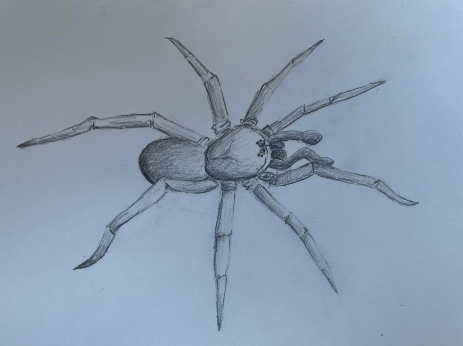New species of spider discovered in Central Queensland, Australia

Evelyn Porter’s pencil sketch of the newly discovered trapdoor spider species, the Euoplos Dignitas.
Earlier this year, a group of museum workers made a shocking discovery – an unidentified species of spider was found in the Queensland Museum’s collection in Australia. Upon realizing it was undescribed, with no information regarding it, intensive fieldwork by researchers led to the scientific discovery of the Euoplos Dignitas, an endangered species of trapdoor spider. Not only was this species scientifically described for the first time, fieldwork also led to the discovery of a new specimen of the rare spider.
The name Euoplos Dignitas is taken from the Latin word for ‘dignity’ or ‘greatness’, paying homage both to this spider’s impressive size and a major sponsor of the fieldwork: Project DIG. Project DIG is a five-year collaboration between the Queensland Museum Network and BHP, a resources company. The collaboration also partners with Interspectral, a technology and software company that helps the public to better understand discoveries through interactive visual software. The first part of the new spider’s name, Euoplos, refers to the genus of Australian armored trapdoor spiders that the Euoplos Dignitas falls into.
As for the appearances of the spider, the descriptions of dignity and greatness hold true. Males can grow up to 3 cm (1.2 in), and females up to 5 cm (2 in). This is considerably larger than most other trapdoor spider species, which typically range from 1.5 cm to 3 cm (0.6 in – 1.2 in). Additionally, while the females are a warm brown, males are much brighter in color with a red outer layer, adding to the brilliance of their appearance.
Being trapdoor spiders, they have a unique tactic for collecting prey. Unlike most common spiders found around here in North America, trapdoor spiders do not make webs. Instead, they use their silk as hinges on a trapdoor made of plant matter and dirt that covers their burrows. When unsuspecting prey wanders near enough, silk “trip” lines alert the spider that food has arrived. Then, the spider springs out of its burrow to catch the prey, before returning to the burrow to lie in wait again.
The average lifespan of wild spiders is about two years, with variation depending on species. For the Euoplos Dignitas, life lasts much longer. Males live in their burrows for five to seven years before venturing out to search for a mate, not living much longer after that. Females can live over twice as long as that, able to live over 20 years in the wild.
The Euoplos Dignitas lives in open woodlands of Queensland, Australia, and has been named an endangered species due to loss of habitat. However, more research is needed to accurately decipher where on the endangerment scale they are. The loss of habitat has been mostly to repurpose woodland for agricultural purposes, as the rich black soil that allows the spiders to build their burrows is also good for farming and livestock.
While there are no known instances of the Euoplos Dignitas biting a human, it is likely to have similar effects as other trapdoor spiders, that is to say, painful but non-fatal. This is because the venom itself has little to no effect on humans, and is not dangerous to people. The venom is non-toxic for humans, and the spider is not aggressive and rarely attacks. Unless provoked and harassed, the spider is no risk to humans.
To confirm that this species is yet to be described scientifically, the Queensland Museum compared physical and genetic structures to other species of spiders in their own collections and from other collections and records. After intensive research, it was determined that the most recent specimen was from 1977. Upon this discovery, researchers took to the open woods of central Queensland to discover new specimens.
In mid-late March of 2023, the discovery of a new specimen was made public. The spider was found in the Bigalow Belt of Queensland, Australia. This specimen allowed researchers to identify many more aspects of the species than their original specimen from 1977. The new specimen is male, unlike the 1977 specimen, and this gave researchers at Project DIG a plethora of new information on the Euoplos Dignitas.
Hopefully, Project Dig, along with other scientific collaborations and efforts across Australia, will be able to discover much more about the Euoplos Dignitas and ways to protect newly discovered endangered species in years to come. As for right now, conservation efforts are happening with attempts to limit loss of habitats for endangered species, and continued research is helping to develop and refine our understanding of the needs of wildlife around the world.

Evelyn is a GHS sophomore and first year writer for The Gillnetter. She enjoys soccer, literature, highland dance and art. She is a member of the Student...

Evelyn is a GHS sophomore and first year writer for The Gillnetter. She enjoys soccer, literature, highland dance and art. She is a member of the Student...











![The GHS/MERHS senior cross country runners pose together on Senior Night. [Photo courtesy of Manchester-Essex Athletics]](https://thegillnetter.com/wp-content/uploads/2025/10/Screenshot-2025-10-10-at-11.18.29-AM.png)
























Rona Tyndall • Apr 13, 2023 at 7:08 pm
Well done, Ms. Porter! Yet another well-researched, well written article proving that the Gillnetter is the best newspaper around. Thank you, for a fascinating read. Peace, Rona Tyndall.